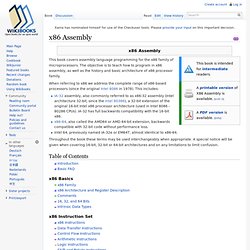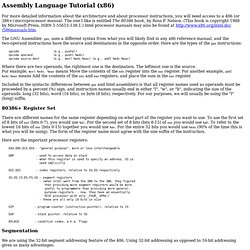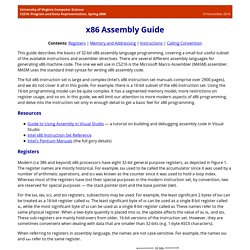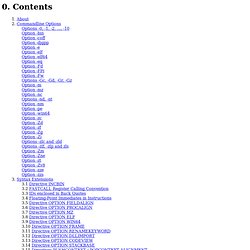Zoom
Trash

x86 Assembly. x86 Assembly This book covers assembly language programming for the x86 family of microprocessors.

The objective is to teach how to program in x86 assembly, as well as the history and basic architecture of x86 processor family. When referring to x86 we address the complete range of x86-based processors (since the original Intel 8086 in 1978). This includes: IA-32 assembly, also commonly referred to as x86-32 assembly (Intel architecture 32-bit, since the Intel 80386), a 32-bit extension of the original 16-bit Intel x86 processor architecture (used in Intel 8086 - 80286 CPUs). Throughout the book these terms may be used interchangeably when appropriate. Introduction Basic FAQ x86 Basics x86 Family x86 Architecture and Register Description Comments 16, 32, and 64 Bits Intrinsic Data Types x86 Instruction Set x86 Instructions Data Transfer Instructions Control Flow Instructions Arithmetic Instructions Logic Instructions Shift and Rotate Instructions Other Instructions x86 Interrupts Syntaxes and Assemblers.
PC Assembly Language. x86 Assembly Language Tutorial. For more detailed information about the architecture and about processor instructions, you will need access to a 486 (or 386+) microprocessor manual.

The one I like is entitled The 80386 book, by Ross P. Nelson. (This book is copyright 1988 by Microsoft Press, ISBN 1-55615-138-1.) Intel processor manuals may also be found at The GNU Assembler, gas, uses a different syntax from what you will likely find in any x86 reference manual, and the two-operand instructions have the source and destinations in the opposite order. Opcode (e.g., pushal) opcode operand (e.g., pushl %edx) opcode source,dest (e.g., movl %edx,%eax) (e.g., addl %edx,%eax) Where there are two operands, the rightmost one is the destination. 80386+ Register Set There are different names for the same register depending on what part of the register you want to use.
Here are the important processor registers: Segmentation We are using the 32-bit segment addressing feature of the 486. Movw seg-reg, seg-reg You can, however, do. x86 assembly Language Guide. Contents: Registers | Memory and Addressing | Instructions | Calling Convention This guide describes the basics of 32-bit x86 assembly language programming, covering a small but useful subset of the available instructions and assembler directives.

There are several different assembly languages for generating x86 machine code. The one we will use in CS216 is the Microsoft Macro Assembler (MASM) assembler. MASM uses the standard Intel syntax for writing x86 assembly code. The full x86 instruction set is large and complex (Intel's x86 instruction set manuals comprise over 2900 pages), and we do not cover it all in this guide. Resources Guide to Using Assembly in Visual Studio — a tutorial on building and debugging assembly code in Visual Studio Intel x86 Instruction Set Reference Intel's Pentium Manuals (the full gory details) Registers Modern (i.e 386 and beyond) x86 processors have eight 32-bit general purpose registers, as depicted in Figure 1. Figure 1. x86 Registers Example declarations: MASM Programmer's Reference. Webster: The Microsoft Macro Assembler (MASM) JWasm. JWasm Manual. 1.

About 2. Commandline Options Options -0, -1, -2, ..., -10 Option -bin Option -coff Option -djgpp. CSCI 240 - Assembly Language Programming - MASM & Intel Docs. Intel Assembler CodeTable 80x86 - Overview of instructions (Cheat Sheet)